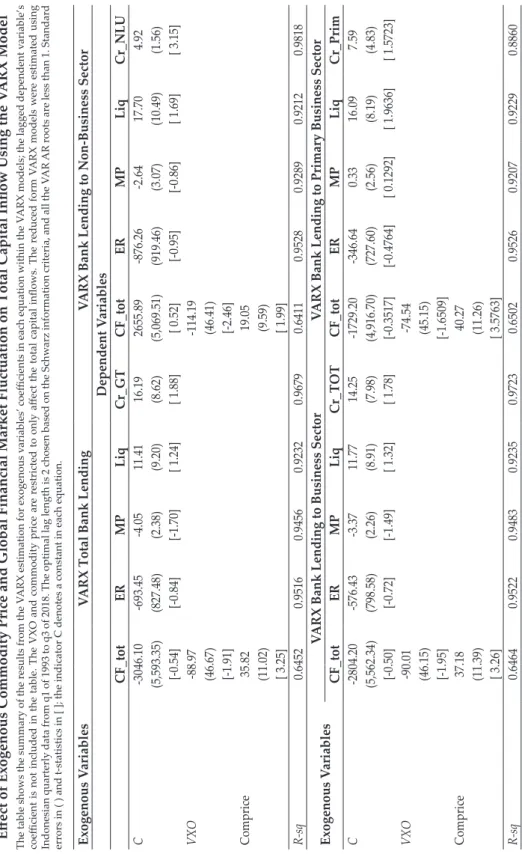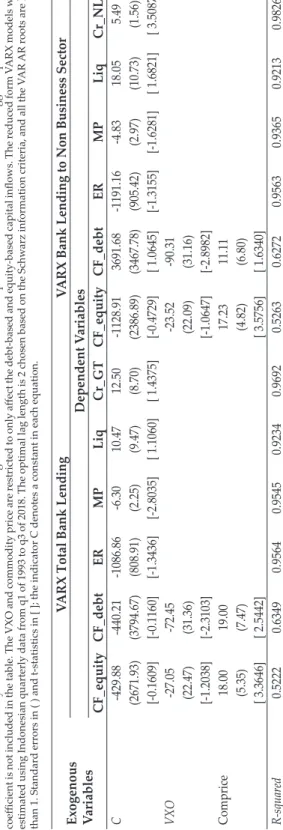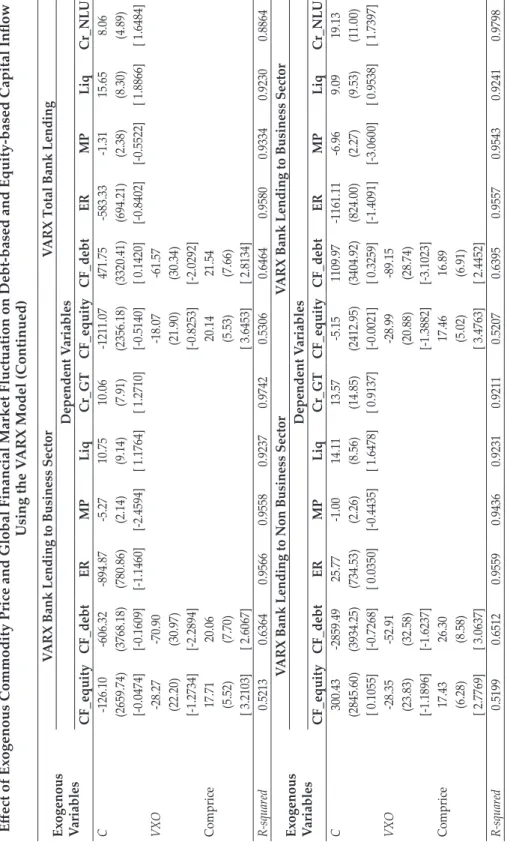Indonesia is one of the highly sensitive countries to the global push factors of capital inflows, along with Brazil, South Africa, Thailand and Turkey (Cerutti et al., 2019). The effect of capital inflows on financial resource allocation has rarely been studied in the literature. The previous literature focused on the financial sector and macroeconomic stability effects of capital inflows to emerging economies.
As a global push factor, commodity prices play an important role in the dynamics of capital inflows. Higher p1 (the economically constrained sector price) lowers the rental rate of capital in the unconstrained sector 2. The exogenous commodity price changes will change the premium relative to the equilibrium rental rate of capital in a commodity-dependent small open economy.
Next, we elaborate on global investor behavior (global factor) to analyze the supply of capital flow to the commodity-dependent economy. Equation (17) is the global investor's total supply of capital flows to the commodity exporting developing economy. In the aggregate equilibrium, conditional on the aggregate risk perception of global investors, the commodity price has a positive effect on the share (supply) of capital flows to the commodity exporting economy.
Commodity prices are the global driver of capital inflows in a commodity-dependent economy.
METHODOLOGY AND DATA
Commodity price has a positive effect on global investor capital flow supply for developing economies exporting commodities, ceteris paribus. We constrained commodity price and global financial market indicators to be strictly exogenous to the dynamics of capital inflows within the SVAR model. Domestic financial sector variables, i.e. nominal exchange rate, domestic liquidity and bank lending, respond to the capital flow shock.
Our SVAR system allows for monetary policy response to the nominal exchange rate, consistent with the empirical findings of Pontines and Siregar (2012) and Juhro et al. In the first step of estimating the reduced form VAR, we set constraints to ensure that there is no feedback effect from the endogenous variables to the strictly exogenous variables. The total capital inflow in equation (19) is assumed to have a simultaneous effect on the nominal exchange rate, monetary policy interest rate, domestic liquidity and bank lending.
Available data ranges from Q1 1993 to Q3 2018. The data period is Q1 1993 to Q3 2018.
EMPIRICAL RESULTS
The immediate reaction of capital inflows to global financial market fluctuations confirms the findings of Forbes and Warnock (2012) and Rey (2015). The short-term response of capital inflows to global financial market shocks shown in Figure 1 is also documented by Cerutti et al. We also further decompose total capital inflows into debt-based and equity-based capital inflows.
Equity-based capital inflows respond immediately by increasing within the first three quarters of a commodity price shock. Based on our result, both commodity prices and global financial market shocks will affect equity-based capital inflows to a commodity-dependent economy. Response of Indonesian debt- and equity-based capital inflows to exogenous external shocks (cont.).
The immediate response of debt-based capital inflows to a commodity price shock is positive in the first quarter and then declines for three quarters before rebounding. In response to a positive shock to global financial market fluctuations, debt-based capital inflows decrease. Second, a positive shock (an increase in volatility) of the global financial market leads to an immediate drop in capital inflows.
The reduction of debt capital inflows is slower than equity capital inflows. We now turn to the standard forecast error variance decomposition to further examine the relative importance of the commodity price shock versus the global financial market shock in explaining capital inflows in Indonesia. These estimates indicate the percentage contribution of commodity prices and global financial market shocks to the variation in total capital inflows.
In the first quarter, about 8.9 percent of the variation in capital inflows is explained by the shock of the world financial market. The global financial market shock has only a short-term effect on capital inflows to Indonesia. We find that debt-based capital inflows have a more persistent response to a commodity price shock than to a global financial market shock.
Response of nominal exchange rate, monetary policy rate and liquidity to gross capital inflows (continued). Our research shows that the allocation of financial assets goes hand in hand with capital inflows caused by commodity price shocks and fluctuations in global financial markets.
ROBUSTNESS CHECK RESULTS
The combination of the openness of capital accounts and the structure of the financial system makes the Indonesian financial system vulnerable to global factor shocks. The implication of our finding is that capital inflows to the commodity-dependent economy would always be highly volatile as long as the international commodity price is highly volatile. It would strain the productive manufacturing sector of the domestic economy due to the redistribution of bank loans to the primary raw materials sector.
In periods of high capital inflows, the expansion of the financial sector leads to excessive risk-taking by banks, which is known as the source of financial instability (Acharya and Naqvi, 2012; Hahm et al., 2013; Korinek and Sandri, 2016) . . In the Indonesian case, Satria and Juhro (2011) found that the risk perception of the banking sector plays an important role in the risk-taking channel of monetary policy transmission. The risk perception of banks and other financial sector institutions weakens the effect of a monetary policy stance.
The Effect of Exogenous Commodity Price and Global Financial Market Fluctuations on Total Capital Inflow Using the VARX Model The table shows the summary of the results from the VARX estimation for the coefficients of the exogenous variables in each equation within the VARX models; the coefficient of the lagged dependent variable is not included in the table. Reduced form VARX models were estimated using Indonesian quarterly data from the first quarter of 1993 to the third quarter of 2018. VXO and commodity price are constrained to affect only debt-based capital inflows and in capital.
The VARX model's IRFs for bank lending to capital inflow shocks, shown in Appendix, Figure A.2, are very similar to those of the SVAR model. The capital inflow shock (conditional on the exogenous factors) changes the distribution of bank loans across the economic sectors in Indonesia. Specifically, the capital inflow shock expands bank lending to non-business and primary commodity producers and contracts bank lending to the other sectors.

CONCLUSION
In Sebastian Edwards (ed.), Capital Controls and Capital Flows in Emerging Economies: Policies, Practices and Consequences: Vol. Pushing factors and capital flows to emerging markets: why knowing your lender is more important than the basics. Gross capital inflow is the data source of non-resident net financial flow (million USD) from Indonesia's balance of payments statistics.
All bank loan data is the nominal outstanding stock of total bank loans of the banking system in billions of rupiah. Sector Bank loans to businesses in the primary sector, secondary sector and tertiary sector as a proportion of their respective GDP sectors. The primary sector is the sum of the agricultural, forestry and fishing industries. The secondary sector is industry, electricity and gas supply, water supply and the construction sector.
The first panel is the behavior of net capital flows in Indonesia decomposed into non-resident capital inflows (liabilities) and resident capital outflows (assets). The bottom panel is the decomposition of capital inflows and capital outflows into debt-based and equity-based flows. All data are in thousands of USD and the data is from Bank Indonesia's Indonesian Balance of Payments Statistics.
The figure presents the IRFs of bank lending to VARX innovation ± 2 standard errors from the total capital inflow shock. The first row presents the IRFs of total bank lending (CR_GT), bank lending to the business sector (CR_TOT) and bank lending to the non-business sector (CR_NLU). The second row presents the IRFs of bank lending to the business sector (CR_TOT) broken down by economic sectors, namely, the primary sector (CR_PRIM), the secondary sector (CR_SEK) and the tertiary sector (CR_TER).



